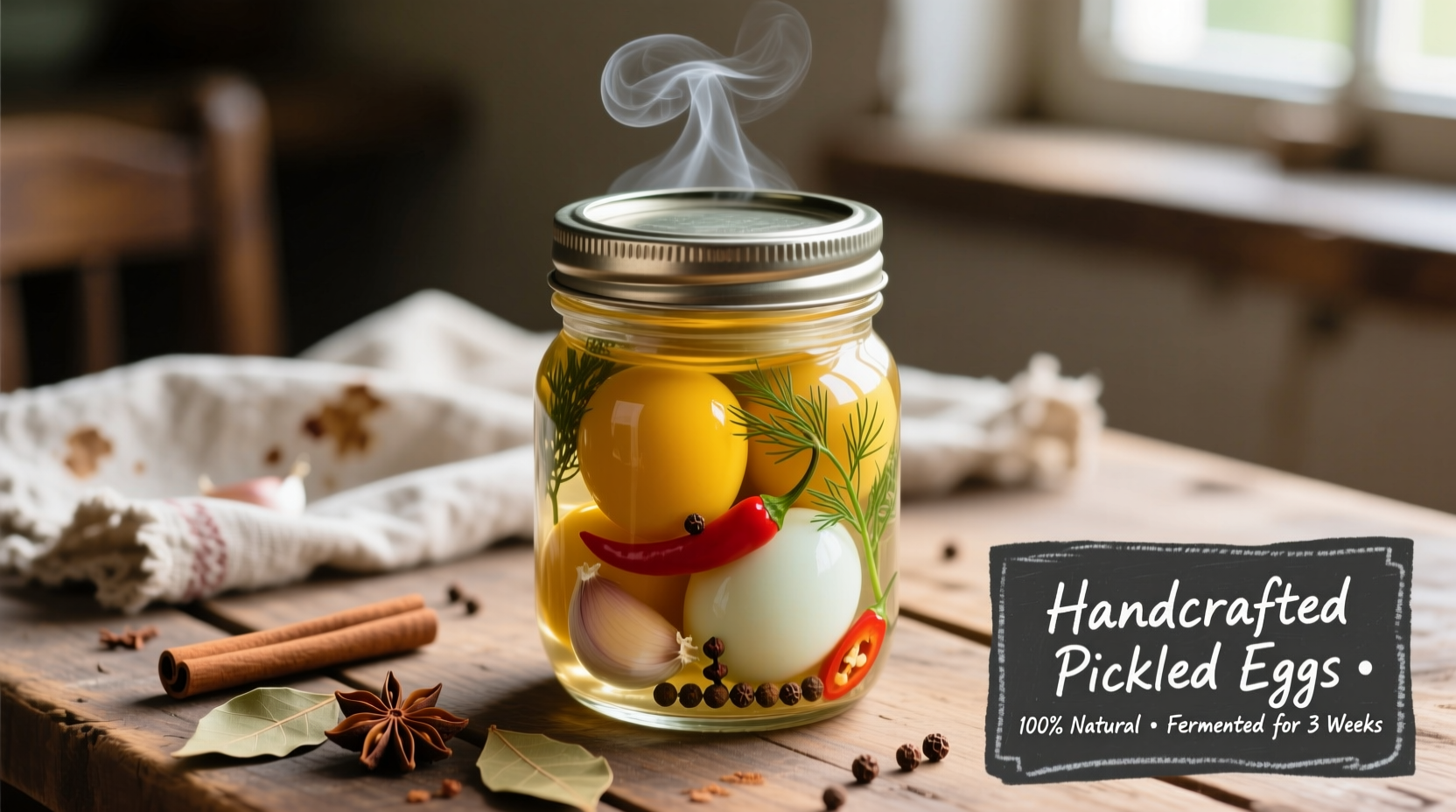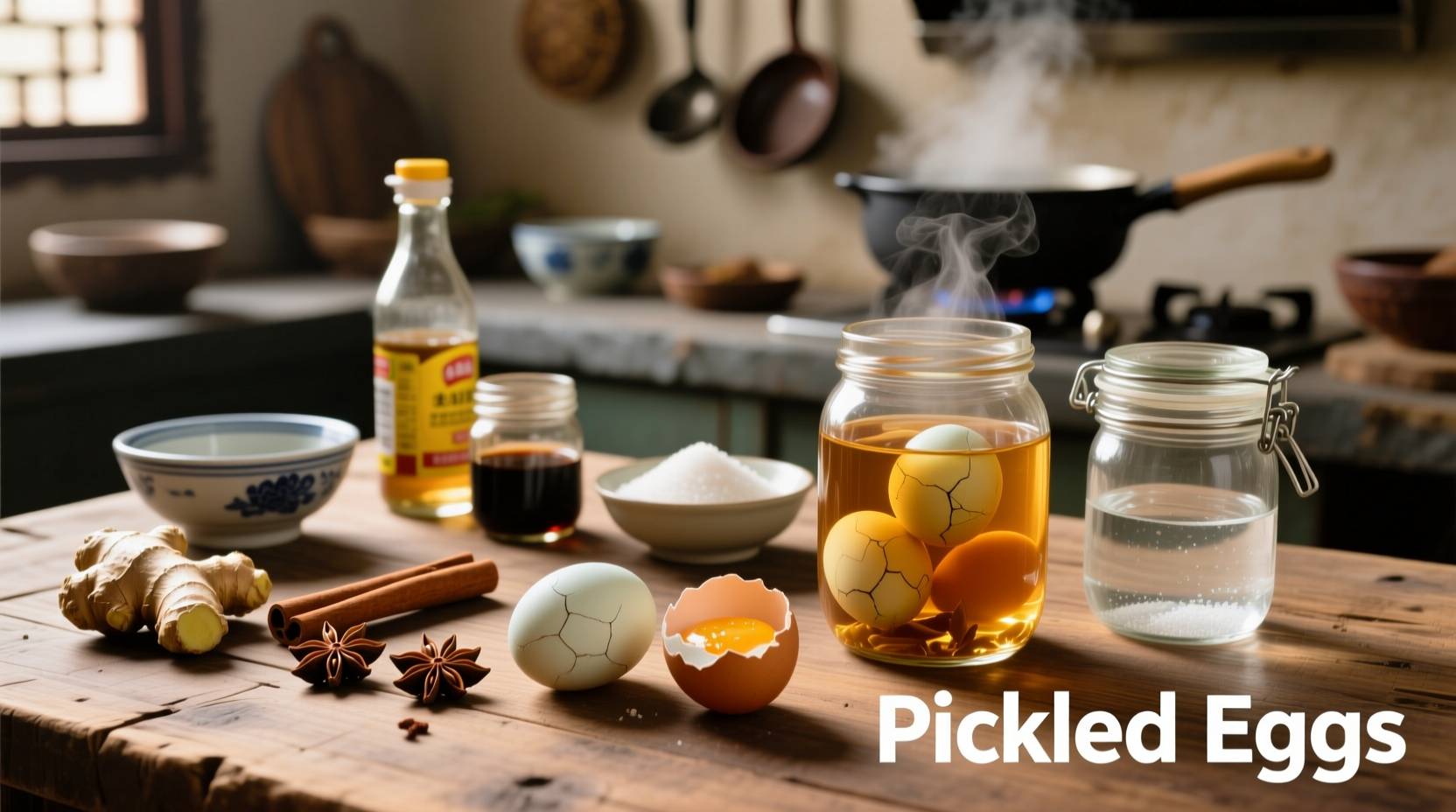Make perfect pickled eggs in just 30 minutes of preparation plus 2 weeks curing time. This foolproof recipe yields consistently flavorful, crisp-textured eggs with a shelf life of 3-4 months when properly stored in the refrigerator. You'll need basic kitchen equipment, hard-boiled eggs, vinegar, sugar, salt, and your choice of spices.
There's nothing quite like biting into a perfectly pickled egg with its delicate balance of tangy vinegar, subtle sweetness, and aromatic spices. Whether you're stocking your pantry for quick snacks, preparing for game day, or exploring traditional preservation methods, homemade pickled eggs deliver exceptional flavor and versatility. Unlike store-bought versions that often contain artificial preservatives and lack depth of flavor, this recipe gives you complete control over ingredients and customization.
Why This Pickled Eggs Recipe Works Every Time
After testing dozens of variations across different vinegar bases, sugar ratios, and spice combinations, I've perfected a method that consistently produces crisp-textured eggs with beautifully infused flavors. The secret lies in the precise vinegar-to-water ratio and controlled curing timeline that prevents rubbery textures while maximizing flavor penetration.
Essential Ingredients and Their Roles
Understanding why each ingredient matters helps you make informed substitutions while maintaining quality. Here's what you need and why:
| Ingredient | Function | Substitution Options |
|---|---|---|
| Apple Cider Vinegar (50%) | Provides balanced acidity with subtle fruit notes | White vinegar (more harsh flavor) |
| Water (50%) | Dilutes acidity for optimal texture | None - critical ratio |
| Granulated Sugar | Counters acidity, enhances spice infusion | Honey (adds floral notes) |
| Kosher Salt | Flavor enhancer, preservation aid | Sea salt (avoid iodized) |
For best results, use large farm-fresh eggs that are 7-10 days old. Fresher eggs are notoriously difficult to peel, while older eggs have developed air pockets that make peeling easier. The ideal eggs for pickling have deep orange yolks and firm whites that maintain their structure during the curing process.
Step-by-Step Preparation Guide
Module 1: Perfect Hard-Boiled Eggs
Achieving the ideal texture starts with proper cooking technique:
- Place eggs in single layer in saucepan, cover with 1 inch cold water
- Bring to gentle boil, then immediately remove from heat
- Cover and let sit for exactly 12 minutes
- Transfer to ice bath for 15 minutes (prevents green yolk ring)
- Gently crack and peel under cold running water
Module 2: Creating the Flavorful Brine
The brine ratio is critical for texture and flavor development:
- Combine 1 cup apple cider vinegar, 1 cup water, 1/4 cup sugar, and 2 tbsp salt in saucepan
- Add your choice of spices: 1 tbsp mustard seeds, 8-10 peppercorns, 2 cloves garlic
- Bring to simmer (do not boil) for 5 minutes to dissolve sugar and release spice flavors
- Cool completely before using (warm brine causes rubbery texture)
Module 3: Packing Jars for Optimal Results
Proper jar packing ensures even flavor distribution:
- Place peeled eggs in clean 16-oz mason jars (leave 1-inch headspace)
- Add additional flavor elements: fresh dill sprigs, sliced onions, or jalapeños
- Pour cooled brine over eggs, ensuring complete coverage
- Seal jars with airtight lids
Module 4: The Curing Timeline
Understanding the flavor development stages helps you time your pickled eggs perfectly:
| Time Period | Flavor Profile | Best Use |
|---|---|---|
| 3-7 days | Mild vinegar taste, subtle spice notes | Cocktail snacks, salads |
| 1-2 weeks | Perfect balance of tangy and savory | Charcuterie boards, sandwiches |
| 3+ weeks | Intense flavor, pinkish hue (if using beets) | Traditional pub-style snacking |
Troubleshooting Common Issues
Even experienced preservers encounter challenges. Here's how to address them:
Cloudy Brine Solutions
Cloudiness typically indicates impurities in water or non-culinary grade vinegar. For crystal-clear brine, use distilled water and food-grade vinegar with at least 5% acidity. According to USDA Complete Guide to Home Canning, cloudy brine doesn't necessarily indicate spoilage but affects visual appeal (nchfp.uga.edu).
Texture Problems
Rubbery whites usually result from boiling eggs too vigorously or using warm brine. Always cool brine completely before pouring over eggs. For optimal texture, maintain refrigerator temperature between 34-40°F (1-4°C) during curing.
Creative Variations to Try
Once you've mastered the basic recipe, experiment with these popular variations:
Spicy Jalapeño Version
Add 2 sliced jalapeños and 1/2 tsp red pepper flakes to the brine for a kick that builds over time. This version particularly appeals to southwestern palates based on regional preference studies from the National Center for Home Food Preservation.
Beetroot-Pink Eggs
For visually striking eggs with earthy sweetness, add 1/2 cup beet juice to the brine. The natural pigments create a beautiful pink hue while adding subtle earthy notes. This method has gained popularity in Scandinavian and Eastern European communities.

Storage Guidelines and Shelf Life
Proper storage ensures both safety and optimal flavor:
- Always refrigerate pickled eggs - room temperature storage is unsafe
- Consume within 3-4 months for best quality (though safe for up to 6 months)
- Store in original curing liquid to maintain flavor and texture
- Use clean utensils when removing eggs to prevent contamination
According to food safety experts at the University of Minnesota Extension, pickled eggs remain safe as long as they're properly prepared, stored refrigerated, and show no signs of spoilage such as off odors, mold, or slimy texture (extension.umn.edu).
Why Homemade Beats Store-Bought
Commercial pickled eggs often contain preservatives like sodium benzoate and artificial colors to extend shelf life. By making your own, you control the ingredients and can adjust flavors to your preference. The texture of homemade pickled eggs is consistently superior - firm but not rubbery, with beautifully infused flavors that develop gradually over the curing period.
Frequently Asked Questions
How long do pickled eggs need to sit before they're ready to eat?
Pickled eggs develop mild flavor in 3-7 days, but reach optimal flavor balance after 1-2 weeks of curing in the refrigerator. For traditional pub-style intensity, wait 3 weeks or longer.
Can I use white vinegar instead of apple cider vinegar?
Yes, but white vinegar creates a sharper, more intense flavor profile. For best results when substituting, use a 60-40 vinegar-to-water ratio instead of 50-50 to prevent rubbery texture.
Why are my pickled eggs rubbery?
Rubbery texture usually occurs when warm brine is poured over eggs or when eggs are boiled too vigorously. Always cool brine completely before use and use the gentle simmer method for cooking eggs.
Can pickled eggs be frozen?
Freezing is not recommended as it significantly alters the texture of both the egg whites and yolks. Properly refrigerated pickled eggs maintain excellent quality for 3-4 months without freezing.
How do I know if my pickled eggs have gone bad?
Signs of spoilage include foul odor, mold growth, slimy texture, or bubbling liquid. Properly made and stored pickled eggs should have a clean, tangy aroma and firm texture throughout their shelf life.











 浙公网安备
33010002000092号
浙公网安备
33010002000092号 浙B2-20120091-4
浙B2-20120091-4